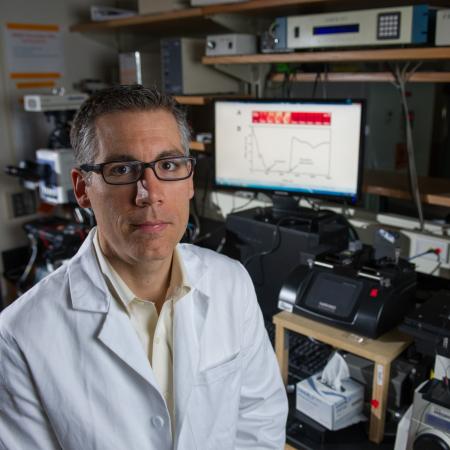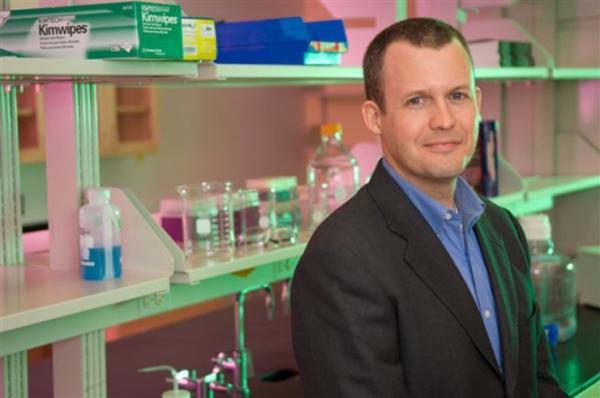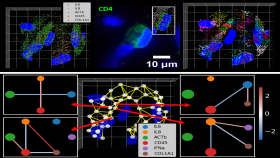Last year, when President Barack Obama announced the BRAIN Initiative (Brain Research through Advancing Innovative Neurotechnologies) at the White House, Bob Guldberg and Craig Forest were in attendance, representing the Georgia Institute of Technology.
Forest, associate professor of bioengineering in the George W. Woodruff School of Mechanical Engineering, and Bob Guldberg, executive director of the Parker H. Petit Institute for Bioengineering and Bioscience, were with about 200 other neuroscientists and neuroengineers, to witness the launch of the president’s ambitious new $300 million public-private program focused on understanding the human brain.
“That was a wonderful day, as the President led the invigorating charge for neuroscience research and the tools to enable it,” says Forest, who is now very much in the game, playing a leading role in the new national initiative that aims to do for neuroscience what the Human Genome Project did for genomics. “I can’t think of anything more exciting to be part of, so I’ve basically been 100 percent in from that day forward.”
And last month, when the National Institutes of Health announced the first wave of BRAIN Initiative funding (totaling $46 million), Forest and his Georgia Tech colleague, Garrett Stanley (professor in the Wallace H. Coulter Department of Biomedical Engineering), were awarded BRAIN Initiative funding from the NIH for a project entitled, “In-vivo circuit activity measurement at single cell, sub-threshold resolution.”
They are principal investigators in a plan to use a robot (developed by Forest and his collaborator at the Massachusetts Institute of Technology, Edward Boyden) to measure precise changes in electrical activity from individual neurons that are connected over long distances across the brain, to understand how these connections change when our brains go into different states, such as sleeping and waking.
“We are leveraging a technique called ‘patch clamping,’ and it’s been around for decades, but up until now, it’s been done manually,” says Forest, whose robotic technique takes patch clamping – the gold standard technique for measuring electrical fluctuations in cells – from a manual skill performed typically in vitro to an automated procedure performed in vivo. The success and potential of the ‘autopatching’ robot over the past year or so is the reason Forest (and Boyden) was invited to the president’s announcement last year.
“No one has been able to record intracellularly from neurons that are connected to each other in a living brain, and that’s what we hope to do,” says Forest, who figures that if his team can measure fluctuations in a healthy brain, they can study the changes that occur with Alzheimer’s, or depression, or epilepsy, or with different drugs and anesthesia.
“We’re trying to understand the basic building blocks. It’s amazing how little we know about the brain,” says Forest, who is spending most of 2014 as a visiting scientist at the Allen Institute for Brain Science in Seattle.
“As humans, we can identify galaxies light years away, we can study particles smaller than an atom,” the president told his audience last year. “But we still haven’t unlocked the mystery of the three pounds of matter that sits between our ears.”
The human brain has about 86 billion neurons that make trillions of connections. But we don’t know how many different cell types comprise these billions of neurons, and that leaves huge gaps in our understanding of that “three pounds of matter,” a major reason why we’re still unable to cure diseases like Alzheimer’s, for example, or to fully reverse the effects of a stroke.
“If you’re building an electrical circuit, you need a battery, capacitors, resistors – you need different components. In the brain, nobody knows how many different components there are, or how they are connected,” says Forest, whose research team was awarded $1.5 million from the NIH. “We still don’t know how the brain is wired, how memories are stored, how the brain develops, and performs computations. So right now, that’s the major thrust of this BRAIN Initiative and neuroscience, to develop a basic understanding.”
Media Contact
Jerry Grillo
Communications Officer II
Parker H. Petit Institute for
Bioengineering & Bioscience
Keywords
Latest BME News
Commercialization program in Coulter BME announces project teams who will receive support to get their research to market.
Courses in the Wallace H. Coulter Department of Biomedical Engineering are being reformatted to incorporate AI and machine learning so students are prepared for a data-driven biotech sector.
Influenced by her mother's journey in engineering, Sriya Surapaneni hopes to inspire other young women in the field.
Coulter BME Professor Earns Tenure, Eyes Future of Innovation in Health and Medicine
The grant will fund the development of cutting-edge technology that could detect colorectal cancer through a simple breath test
The surgical support device landed Coulter BME its 4th consecutive win for the College of Engineering competition.
New research from Georgia Tech helps doctors predict how therapies will interact with a child's immune system, potentially improving outcomes and reducing risks.









